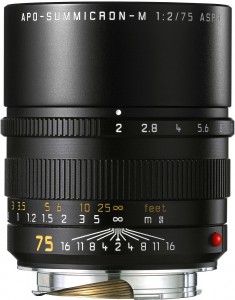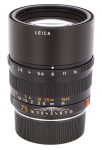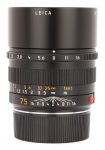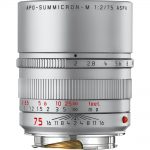Announced
Production status
Original name
System
Pros and cons
Genres or subjects of photography
Recommended slowest shutter speed when shooting static subjects handheld
Leica APO-Summicron-M 75mm F/2 ASPH.
Short telephoto prime lens • Film era
Abbreviations
| APO | Apochromatic optical design. |
| ASPH. | The lens incorporates aspherical elements. |
Model history
| ■Leica APO-Summicron-M 75mm F/2 ASPH. [11637, 11701] | M | 7 - 5 | 0.70m | E49 | 2005 ● | |
| Leica APO-Summicron-M 75mm F/2 ASPH. "Drifter" (125 units) | 2019 ● | |||||
Specification


| Optical design: | |
| 75mm | |
| F/2 | |
| 35mm full frame | |
| Leica M | |
| 32.2° (35mm full frame) | |
| 7 elements in 5 groups | |
| 1 ASPH, 2 AD, 2 HR | |
| Floating element system | |
| On Leica M8/M8.2 APS-H [1.33x] cameras: | |
35mm equivalent focal length: | 99.8mm (in terms of field of view) |
35mm equivalent speed: | F/2.7 (in terms of depth of field) |
Diagonal angle of view: | 24.5° |
| Diaphragm mechanism: | |
Diaphragm type: | Manual |
Aperture control: | Aperture ring |
| 9 (nine) | |
| Focusing: | |
Coupled to the rangefinder: | Yes |
| 0.7m | |
| 1:7 | |
Focusing modes: | Manual focus only |
Manual focus control: | Focusing ring |
| Physical characteristics: | |
| 430g | |
| ⌀58×66.8mm | |
| Accessories: | |
| Screw-type 49mm | |
| Built-in telescopic round | |
| 14001 (front) | |
| 14269 (rear) | |
| 14379 (rear) |
Source of data
- Manufacturer's technical data.
Manufacturer description #1
01 - 05/2005 - New: LEICA APO-SUMMICRON-M f/2/75 mm ASPH.
Leica Camera AG, Solms has added a compact medium telephoto to its range of lenses for Leica rangefinder cameras. The LEICA APO-SUMMICRON-M f/2/75 mm ASPH. is the first lens of this focal length class to feature a floating element: During focusing, the last lens element change their position in relation to the rest of the optical system. The LEICA APO-SUMMICRON-M f/2/75 mm ASPH. is thus able to offer superlative quality in the close-focus range down to 0.7 meters. To take full advantage of the floating element, a highly precise adjustment mechanism has been used, although finding the space for it in a compact M lens was no easy feat!
The extremely natural perspective of the 75mm focal length enables true-to-life rendering of the subject and is useful for many applications ranging from portrait to reportage photography. “True-to-life photographs happen spontaneously – in the daytime and at night, from a distance or at close quarters. The universal LEICA APO-SUMMICRON-M f/2/75 mm ASPH. is ideal in these situations. For example, it produces a natural 3D effect in portraits so that the face's highlights and contours are emphasized without looking artificial. The high-speed LEICA APO-SUMMICRON-M f/2/75 mm ASPH. performs just as well in available light situations, too, where use is made of the small amount of natural light, leading to emotional, extremely natural results. The lens's compact dimensions – the field of view of the 75mm viewfinder frame is not restricted by the lens on the camera – make for excellent handling. Together with a Leica wide-angle lens, the universal LEICA APO-SUMMICRON-M f/2/75 mm ASPH. forms a versatile camera outfit,” says Jean-Jacques Viau, Product Manager Photo at Leica Camera AG.
Even at full aperture, the LEICA APO-SUMMICRON-M f/2/75 mm ASPH. produces high contrast even of the finest structures. This performance can only be improved slightly by stopping down. Distortion is a mere 1%. The vignetting is normal for high-speed lenses – here up to about 1 stop in the picture corners – is reduced further by stopping down: At f/2.8 it is already negligible apart from the far corners, and at f/5.6 it has disappeared from corners as well. The use of state-of-the-art coating technology and the additional of a new textured matt-finishing to the interior mount guarantees minimum reflections, ensuring natural images at any distance and in any light.
The optical design consists of seven lens elements in five component groups. A homogeneously high imaging performance over the entire image field is achieved by using high-refraction glass types, two with partial anomalous dispersion, one of which originates from the former Leitz glass laboratory.
“Like all Leica lenses, the LEICA APO-SUMMICRON-M f/2/75 mm ASPH. was developed by Leica optic specialists. It is a particularly reliable and long-lasting product made of high-quality materials and meticulously assembled by hand at our Solms factory. The combination of state-of-the-art technology and experienced craftsmanship ensures the constant quality of every single Leica lens,” adds Jean-Jacques Viau.
The LEICA APO-SUMMICRON-M f/2/75 mm ASPH. comes with a built-in telescopic lens hood as protection against stray light or dirt. It can be locked in position to prevent it being inadvertently pushed in. The well-balanced proportions of the lens encourage hours of comfortable use.
The LEICA APO-SUMMICRON-M f/2/75 mm ASPH. will be available at selected Leica dealers from June 2005.
Manufacturer description #2
By day and night, at a distance or close-up, this Summicron sets new standards. Its high-speed and medium telephoto focal length combined with its compact dimensions make it a flexible alternative. It is particularly well suited to brilliant close-ups and intimate available light portraits with natural perspectives and appealing plasticity. With its wide aperture and limited depth of field, you can emphasize particular areas of the subject for more impact. All details are reproduced in high contrast and true to life, even at maximum aperture. The compact size belies its sophisticated features, including a floating element, an aspherical element, and apochromatic correction
Manufacturer description #3
This compact, fast, short telephoto lens is acclaimed for its excellent image quality at maximum aperture and over the full focusing range from infinity to minimum distance. The speed of this powerful lens allows to single out a sharp detail on a blurred background. Still, the lens offers a natural angle of view that can not be achieved with 90mm telephoto lenses.
This compact lens uses all of today’s technical possibilities to achieve high speed and remarkable imaging quality. It features aspherical surfaces, special glass types with partial anomalous dispersion and floating elements. It is the ideal lens for delivering intimate views of scenes, nature, landscapes and people, whether at infinity or at close-focus range.
Manufacturer description #4
The new LEICA APO-SUMMICRON-M 75mm f/2 ASPH. extends the range of telephoto lenses in the Leica M system with a fast high-performance model that is simultaneously extremely compact.
With its more natural perspective compared to a 90mm focal length, where depth is reproduced with less compression, it is ideally suited for many applications including reportage and portraits - particularly in smaller rooms. Its small dimensions result in not only outstanding handling but also a Leica M viewfinder image that is almost completely free of shadowing, thus allowing totally undisturbed viewing of the subject. Whether you are using full stop to deliberately "isolate" critical parts of the subject or working in high-contrast available light - both very common in applications with these focal lengths - or stopping down for sharp reproduction of more extensive areas of the subject, the LEICA APO-SUMMICRON-M 75mm f/2 ASPH. is convincing in any situation: At full stop, it offers excellent contrast reproduction, even for very fine structures. This performance can only be slightly improved by stopping down. Another outstanding feature is the extremely low distortion of only 1%. The vignetting that is normal for fast lenses at their maximum opening - up to approx. 1 stop in the corners of the image here - is further reduced by stopping down: At f/2.8, it is negligible, except for the extreme corners and at f/5.6 it is negligible even in the corners.
The use of state of the art coating technology and additional measures for dulling the inner parts of the mount also ensure a high degree of freedom from reflection. The optical system comprises seven lens elements in five groups. As on the recently introduced Summilux 50mm ASPH., they are a new version of the double Gauss lens type, with the first three lens elements corresponding to the typical Gauss design. The elements behind the aperture are very similar to those on the Summilux 50mm ASPH. - apart from the use of a single lens instead of one of the two cemented lens element groups. To achieve the excellent imaging performance, glass with anomalous partial dispersion is used (no. 2/3). Lens element no. 2 is made of a fluorite-type glass, while the glass used for lens element 3 can trace its origins back to the former Leitz glass laboratory. Lens element no. 4 has a pressed aspherical surface. To minimize monochromatic aberrations, as well as having an aspherical shape the glass used is also highly refractive (no. 5/6).
To maintain the outstanding imaging performance even at the minimum range of 0.7m - the Summilux-M 75mm only achieves 1m - as on the Summilux-M 50mm ASPH., a so-called floating element is used. This final lens element (no. 6/7) changes its position relative to the rest of the optical system during focusing. While the fundamental technology is common in SLR lenses, to achieve this in a compact M lens with its very limited space, the Leica designers had to develop a brand new, extremely precise adjusting mechanism. Its use allows the benefits of this design to be utilized to the full, while at the same time guaranteeing the familiar silky smooth and absolutely accurate focusing of the M lenses.
A feature that has now become a standard for Leica lenses has also been included on the new LEICA APO-SUMMICRON-M 75mm f/2 ASPH.: The built-in lens hood, which protects against stray light and dirt, can be locked in its extended position to prevent it accidentally being pushed back in.
Summary: By utilizing every means available in lens technology today - an aspherical surface, glass with anomalous partial dispersion and a high refractive index, a floating element including a brand new, high-precision adjusting mechanism, state of the art coating techniques and sophisticated measures to reduce internal reflection - we have created a lens that not only extends the Summicron-M range but also sets new standards in this focal length class. In the group of four fast M telephoto lenses with focal lengths of 75 and 90mm, the new LEICA APO-SUMMICRON-M 75mm f/2 ASPH. represents an ideal combination of several properties: It combines optimum imaging quality with high speed and compact dimensions. In conjunction with its moderated telephoto perspective, this makes it ideal for almost any application, and along with a wide-angle lens it forms a complete and versatile but still very compact equipment set.
Manufacturer description #5
February 14th, 2020
Leica Camera AG presents three new lenses for the Leica M-System: the silver anodized APO-Summicron-M 75 f/2 ASPH. as well as the limited-edition Summicron-M 28 f/2 ASPH. and APO-Summicron-M 90 f/2 ASPH. in an olive green “Safari” finish. The technical specifications of the three new lenses are identical to those of their serially produced counterparts. All three lenses are available from end of February.
The APO-Summicron-M 75 f/2 ASPH. counts among the most high-performing lenses for the Leica M, and is particularly well suited to portrait photography. Now the lens is also available in a silver anodized finish which perfectly emphasizes its sophisticated design. In contrast to the black-paint variant, the feet markings on the distance scale as well as the focal length engravings are inlaid in red, while all other engravings feature black inlays.
Other short telephoto prime lenses in the Leica M system
Sorted by focal length and speed, in ascending order
| ■Leica M mount (22) | |||||||||
| Leica Summarit-M 75mm F/2.5 [11645] | M | 6 - 4 | 0.90m | E46 | 2007 ● | ||||
| Leica Summarit-M 75mm F/2.4 [11682, 11683] | M | 6 - 4 | 0.70m | E46 | 2014 ● | ||||
| Leitz Canada Summilux-M 75mm F/1.4 Type 1 [11814] | M | 7 - 5 | 0.90m | E60 | 1980 ● | ||||
| Leitz / Leica Summilux-M 75mm F/1.4 Type 2 [11815] | M | 7 - 5 | 0.75m | E60 | 1982 ● | ||||
| Leica Summilux-M 75mm F/1.4 Type 3 [11810] | M | 7 - 5 | 0.75m | E60 | 1998 ● | ||||
| Leica Noctilux-M 75mm F/1.25 ASPH. [11676] | M | 9 - 6 | 0.85m | E67 | 2017 ● | ||||
| Leitz Wetzlar Elmar 90mm F/4 [I] Type 4 [ILNOO / 11131, 11631] • Collapsible | M | 4 - 3 | 1.00m | E39 | 1954 ● | ||||
| Leitz Wetzlar Elmar 90mm F/4 [I] Type 3 [ELGAM / 11830, ELANG-M / 11130] | M | 4 - 3 | 1.00m | E39 | 1954 ● | ||||
| Leitz Wetzlar Elmar 90mm F/4 [II] [11830, 11128] | M | 3 - 3 | 1.00m | E39 | 1964 ● | ||||
| Leitz Wetzlar Elmarit 90mm F/2.8 [ELRIM / 11129, 11026] | M | 5 - 3 | 1.00m | E39 | 1959 ● | ||||
| Leitz Wetzlar / Leitz Canada Tele-Elmarit 90mm F/2.8 [I] [11800] | M | 5 - 5 | 1.00m | E39 | 1964 ● | ||||
| Leitz / Leitz Canada Tele-Elmarit-M 90mm F/2.8 [II] [11800] | M | 4 - 4 | 1.00m | E39 | 1974 ● | ||||
| Leica Elmarit-M 90mm F/2.8 [III] [11807, 11808] | M | 4 - 4 | 1.00m | E46 | 1989 ● | ||||
| Leica Summarit-M 90mm F/2.5 [11646] | M | 5 - 4 | 1.00m | E46 | 2007 ● | ||||
| Leica Summarit-M 90mm F/2.4 [11684, 11685] | M | 5 - 4 | 0.90m | E46 | 2014 ● | ||||
| Leica Thambar-M 90mm F/2.2 [11697] | M | 4 - 3 | 1.00m | E49 | 2017 ● | ||||
| Leitz Canada Summicron 90mm F/2 [I] Type 1 [SOOZI-M / 11127] | M | 6 - 5 | 1.00m | E48 | 1957 ● | ||||
| Leitz Canada Summicron 90mm F/2 [I] Type 2 [11122, SEOOM / 11123, OESBO / 11124, OERDO / 11126, 11133, 11132] | M | 6 - 5 | 1.00m | E48 | 1959 ● | ||||
| Leitz Summicron-M 90mm F/2 [II] Type 1 [11136, 11137] | M | 5 - 4 | 1.00m | E49 | 1980 ● | ||||
| Leica Summicron-M 90mm F/2 [II] Type 2 [11136, 11137] | M | 5 - 4 | 1.00m | E55 | 1982 ● | ||||
| Leica APO-Summicron-M 90mm F/2 ASPH. [11884, 11885] | M | 5 - 5 | 1.00m | E55 | 1998 ● | ||||
| Leica Summilux-M 90mm F/1.5 ASPH. [11678] | M | 8 - 6 | 1.00m | E67 | 2019 ● | ||||
Lenses with similar focal length
Sorted by manufacturer name
| ■Leica M mount (3) | |||||||||
| Cosina Voigtlander Heliar 75mm F/1.8 VM | M | 6 - 3 | 0.90m | ⌀52 | 2010 ● | ||||
| Cosina Voigtlander Nokton 75mm F/1.5 Aspherical VM | M | 7 - 6 | 0.70m | ⌀58 | 2019 ● | ||||
| Cosina Voigtlander Ultron 75mm F/1.9 VM | M | 7 - 5 | 0.50m | ⌀49 | 2023 ● | ||||
| ■Leica screw mount (4) | |||||||||
| Cosina Voigtlander Color-Heliar 75mm F/2.5 MC LSM | M | 6 - 5 | 1.00m | ⌀43 | 1999 ● | ||||
| Leitz Wetzlar Hektor 73mm F/1.9 [HEKON, HEKONKUP, HEKONCHROM, HEGRA, HEGRAKUP, HEGRACHROM] | M | 6 - 3 | 1.50m | A42 | 1931 ● | ||||
| Rollei HFT Planar 80mm F/2.8 LSM (90 units) | M | 5 - 4 | 1.20m | ⌀43 | 2002 ● | ||||
| Sankyo Kohki Komura 80mm F/1.8 LSM | M | 5 - 4 | 1.25m | ⌀48 | ● | ||||



